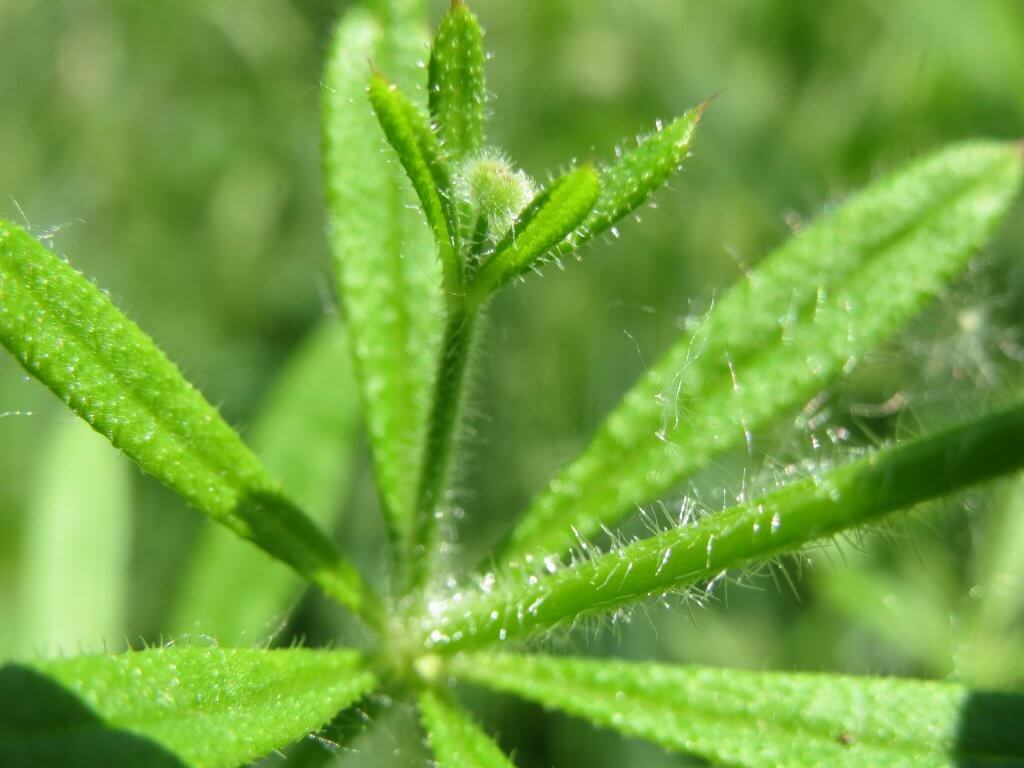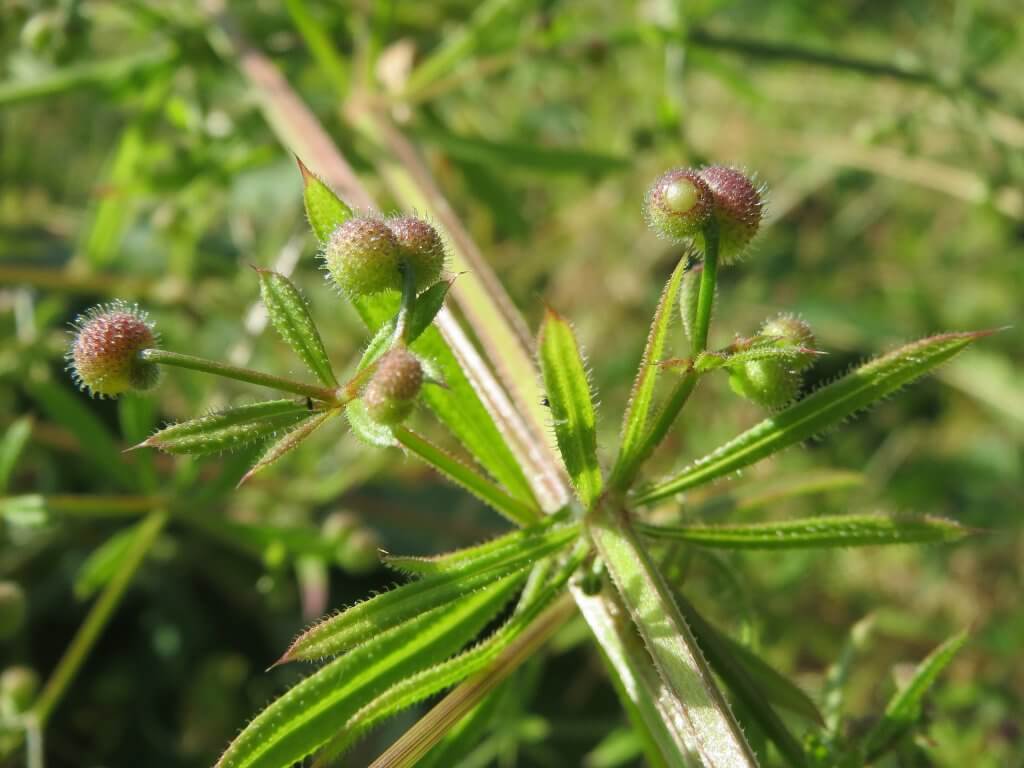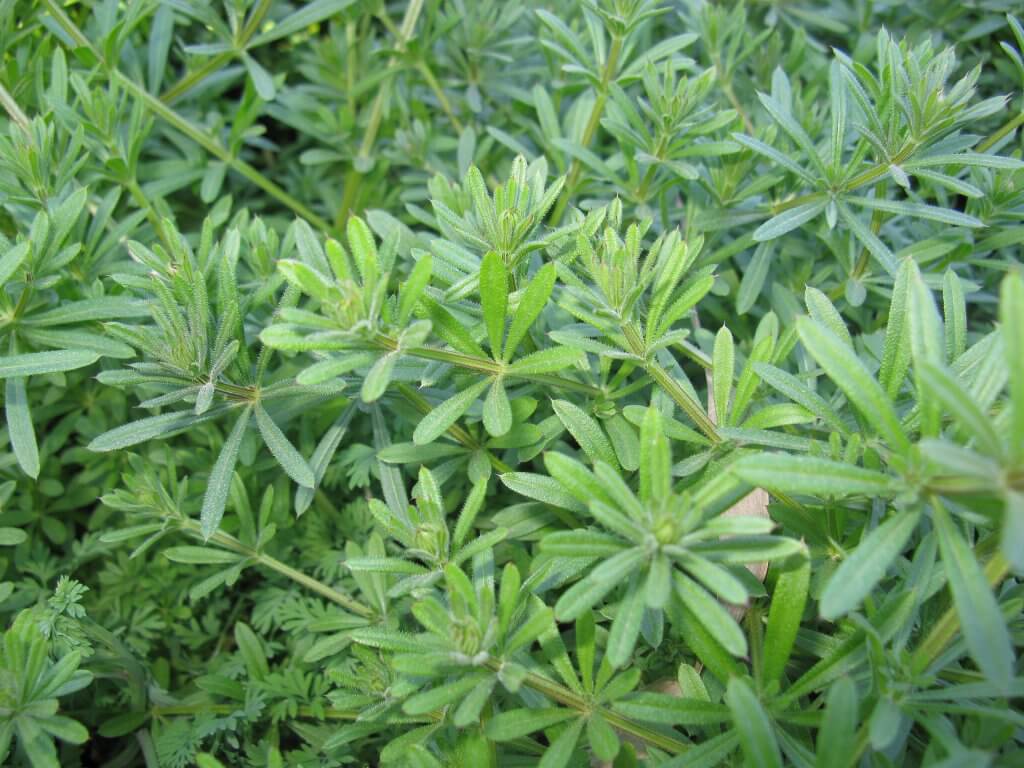Cleavers Bedstraw (Galium aparine), is a herbaceous weed that we may be familiar with from childhood. It’s other common names include catchweed, stickyweed and grip grass, to name but a few. These names hint at its ability to grasp onto and stick to things. From the the long socks of a hiker, the wool of a sheep, to the back of your friends jumper.
It is originally native to Europe, parts of Northern Africa and also wide areas of temperate Asia. However through trading and colonisation, this sticky weed has found itself in many locations around the world, particularly North America.

The tiny hook shaped hairs coating the leaves and stems give cleavers bedstraw its ability to stick to other fuzzy textures. This is a evolutionary adaption to help the plant in widespread seed dispersal. The scientific name for cleavers bedstraw, Galium aparine, again hints at its sticking ability, ‘aparine’ means “to seize” in latin.
The plant is annual, meaning it grows quite prolifically during the spring and summer months. The stems creep along the ground and branch out to envelop other nearby plants. Small and thin, lance shaped leaves appear in radial formations around the square stems, at regular intervals. The tiny, subtle flowers develop into hairy seed filled burrs, which can easily attach themselves to passers-by.
Edible parts and other uses
The young shoots and leaves of cleavers bedstraw are perfectly edible. Although they are usually at their best flavor before flowering begins. The flavor can be quite bitter, so it can be an acquired taste for some. They become much more mild when cooked through, so using the leaves in a soup or stew would be a great way to experiment with them first.
The fruits (burrs) of cleavers bedstraw, like chicory roots, have even been used as a coffee substitute. When dried, roasted and ground they create a bitter powder which has much less caffeine than traditional coffee.

Cleavers bedstraw also has a long history of use as a medicinal herb in folk medicine. It was used as a poultice for irritated or burnt skin, and consumed to aid with urinary problems. A hot or cold tea can be made by infusing the leaves in water overnight. This is said to aid in draining toxins from the lymphatic system.
Cautions
Cleavers bedstraw can be a plant that is notorious for causing contact dermatitis in those who have sensitive skin. When harvesting it is best to wear gloves to protect your hands just incase it causes irritation.
Astringent compounds can also be found in cleavers bedstraw. While this provides a useful medicinal property in some circumstances, it makes it unsuitable for eating in great quantities for a long period of time.
Pregnant women and those with high blood pressure should also look to avoid cleavers bedstraw. It could possibly cause uterine contractions and its anti-coagulant properties could affect the thickness of blood and the contraction of blood vessels.
Foraging
Look at the base of hedgerows, forest and lake edges and even your own yard or plot of land. Cleavers bedstraw thrives in moist soils, even those with poor drainage, giving it the upper edge over some other plants. As an abundant weed, you can generally forage as much as needed. However it may be wise to wear gloves when harvesting.

Did you know…
Cleavers bedstraw drew its name from its usage as a mattress filling in many parts of Europe. It was readily available, free, and its sticky stems padded out a mattress in an even and plump way.
Conclusion
A weed to some, but an eye opening wild edible to others. Cleavers bedstraw has a varied and interesting history of usage. It is an abundant wild edible that you can experiment with, from making your own coffee to preparing a wild edibles soup. The plant is also a great choice for fodder and animal feed if you keep animals. Chickens and geese are particularly partial to the leaves, hence another common name ‘goose grass’.
—————Written by Hannah Sweet
Hannah is a freelance writer and graphic designer from the UK. With a penchant for travelling, photography and all things botanical, she enjoys writing about a wealth of topics and issues, from conservation and slow living, to design and travel. Learn more about her writing and design services at www.sweetmeanders.co
Many of our readers find that subscribing to Eat The Planet is the best way to make sure they don't miss any of our valuable information about wild edibles.
See our privacy policy for more information about ads on this site







One Response
I read your article about BED STRAW it’s interesting but I have a question. I have this plant growing in my hedge row and my question is. Can this plant damage my hedge and how do I get rid of it?